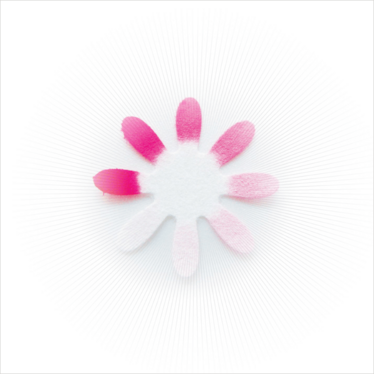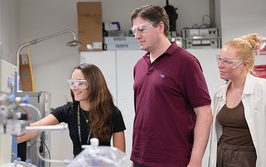Crafty Diagnostics
Could a simple flower-shaped paper-based assay be the answer to an undiagnosed hepatitis C pandemic?

Xuan Mu, assistant professor at the Institute of Basic Medical Sciences at Peking Union Medical College, China, was shocked to discover the “astonishing circumstance” surrounding global hepatitis C virus (HCV) infections. “The majority of virus carriers are simply unaware of their infections – and millions of people at risk (like baby boomers) are recommended to receive HCV screening tests,” says Mu. “We believe that diagnostic advances are crucial to address the ‘silence’ of the HCV pandemic.” With that in mind, Mu and colleagues set out to use advances in paper-based microfluidics and a flower-shaped craft tool to tackle the issue (1).
Those who read George Whitesides’ feature in the April issue (tas.txp.to/0614/whitesides) will already realize the potential of simple and cheap diagnostic tools. “Certainly, we were inspired by previous paper-based analytical devices from the Whitesides Group,” says Mu, “The unique insights of George Whitesides for patterning paper and stacking it in a 3D manner will undoubtedly launch a new era of paper-based analysis. And we feel fortunate to be involved in this trend.”
Not only is paper cheap, it can also be appropriately patterned to create the specific zones required for the lengthy and segmented HCV diagnostic, which uses an enzyme-linked immunosorbant assay (ELISA) for screening and a recombinant immunoblot assay (RIBA) for confirmation. However, patterning the paper also poses a challenge. Most conventional patterning methods use high temperatures and it is therefore unwise to use them with highly flammable paper, such as nitrocellulose – one of the few types of paper that can efficiently bind proteins.
“The idea of using scrapbooking tools or craft punches came to me by chance. My original concept was to combine paper origami and scissors to pattern complicated features on paper,” says Mu. “But when I searched online to learn how to easily cut a curved line on folded paper, I chanced upon a craft punch that could do the job far more reproducibly. I soon realized that this scrapbooking tool could be very useful in patterning paper for analytical purposes”. The group has called the approach “craft punch patterning” (what else?) and touts it as precise, inexpensive, versatile and convenient for prototype research.
After a few false starts and optimization steps, the team realized they had successfully created a quantitative, multiplex immunoassay that can be performed in minutes rather than hours. What’s more, the test can be completed with around 2000 times less serum (around 6 nL per detection zone) than the conventional ELISA and RIBA tests – something that shocked the team. “Being able to perform the test with such extremely low volumes of serum is not only beneficial to patients, but also highlights opportunities for non- or minimally-invasive detection,” says Mu.
With an eye on the horizon, Mu believes the flower assay can help change the diagnostic landscape for HCV and hopes to roll out similar devices for other infectious diseases, such as HIV and hepatitis B. Until then, the group plans stepping up hospital collaborations to get its hands on more samples to help fully optimize the test.
- Xuan Mu et al., “Multiplex Microfluidic Paper-based Immunoassay for the Diagnosis of Hepatitis C Virus Infection”, Anal. Chem. 86 (11), 5338-5344 (2014).

Rich Whitworth completed his studies in medical biochemistry at the University of Leicester, UK, in 1998. To cut a long story short, he escaped to Tokyo to spend five years working for the largest English language publisher in Japan. "Carving out a career in the megalopolis that is Tokyo changed my outlook forever. When seeing life through such a kaleidoscopic lens, it's hard not to get truly caught up in the moment." On returning to the UK, after a few false starts with grey, corporate publishers, Rich was snapped up by Texere Publishing, where he spearheaded the editorial development of The Analytical Scientist. "I feel honored to be part of the close-knit team that forged The Analytical Scientist – we've created a very fresh and forward-thinking publication." Rich is now also Content Director of Texere Publishing, the company behind The Analytical Scientist.

















